The Great Dane is the tallest dog breed on earth with the Guinness breaking record awarded to Zeus, who had an outstanding height of 44 inches. Despite their statute, they are gentle giants, unruly, and have a great personality.
Standardbred regulations allow for six acceptable types of Great Danes, with several other uncommon kinds. They include; Fawn, Brindle, Blue, Black, Harlequin, and Mantle Great Dane. Other unfamiliar types include the merle, spotted, and chocolate Great Dane. Additionally, there are two distinct types of great Dane differentiated by location – American vs the European Great Dane.
All these types exhibit a charming personality even though they may also have their differences. Learn about these interesting types of Great Danes right below. Read on!
The European vs American Great Dane
These two types of Great Danes primarily differ from the original location. European Danes originated from Europe where they’re organically bred into European Great Danes.
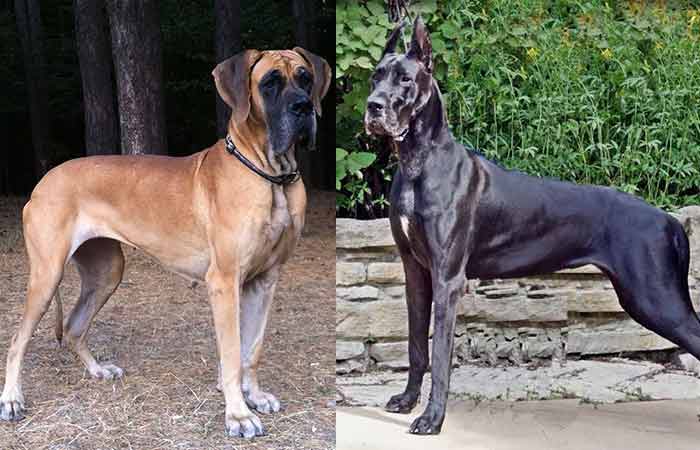
Whereas American Danes are from America. Although most believe European Great Danes were exported to America where they also began their breeding.
There isn’t much difference between the two except in small details, here and there;
Appearance
European Great Danes have a Mastiff’s look, bigger and have more mass than those from America. They have a heavier square-shaped head which puts their body to head ratio a bit disproportionate.
Their lips are also bigger and tend to hang. The European Danes have extra droopy eyes and a rather long and thick neck.
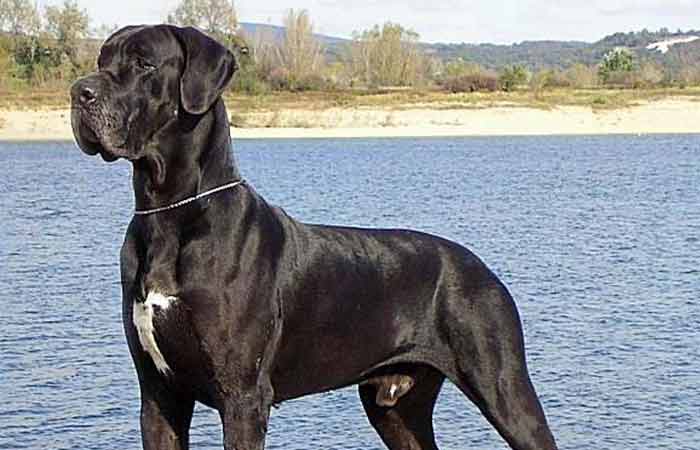
The American kind, on the other hand, looks more like a greyhound; taller, slimmer, and sleeker. Their head is small and perfectly proportionate to its sturdy physique. The head is also rectangular in shape rather than square.
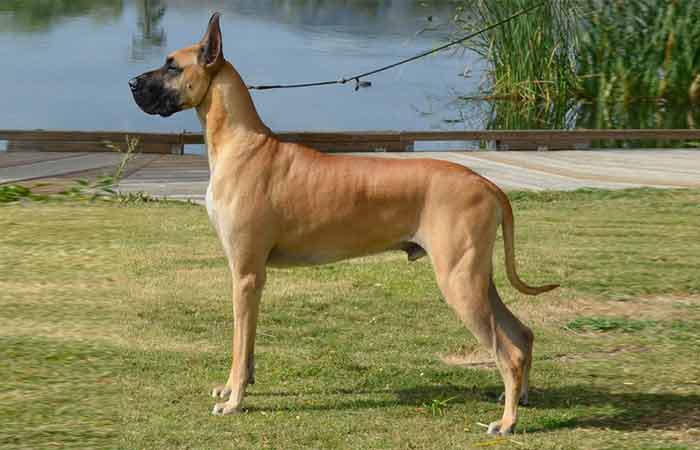
Their overall weight appears lighter than those of European descent with an average weight of 125-135 lbs compared to 220-240 lbs from the European Great Danes.
Temperament
Great Danes are gentle giants; very playful and goofy enjoys spending time with family and naturally loyal to their owners. European Danes are less playful and prefer to be in their comfort zone while the American kind enjoys more goofiness like jumping around, leaping, and using more energy.
Color Differentiated Great Danes
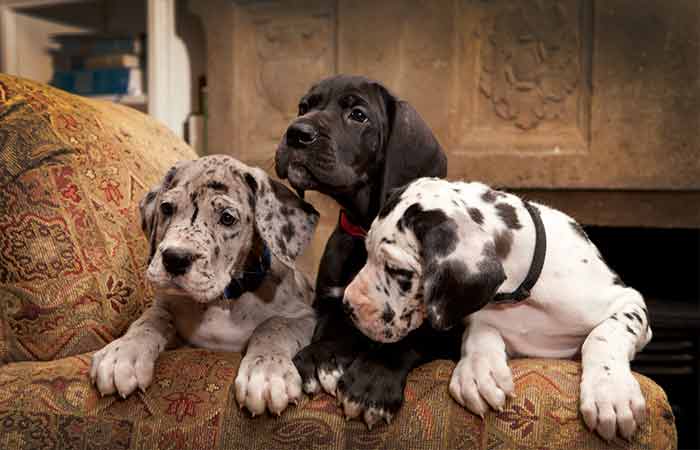
Great Danes have three color groups. From each group, there are two distinct colors. They’re;
Fawn and Brindle
Fawn – a yellow-gold hue with a black mask, dark eye rims, and eyebrows, plus a dark tint on the ears.

Brindle – a hue between black and fawn with a chevron stripe pattern
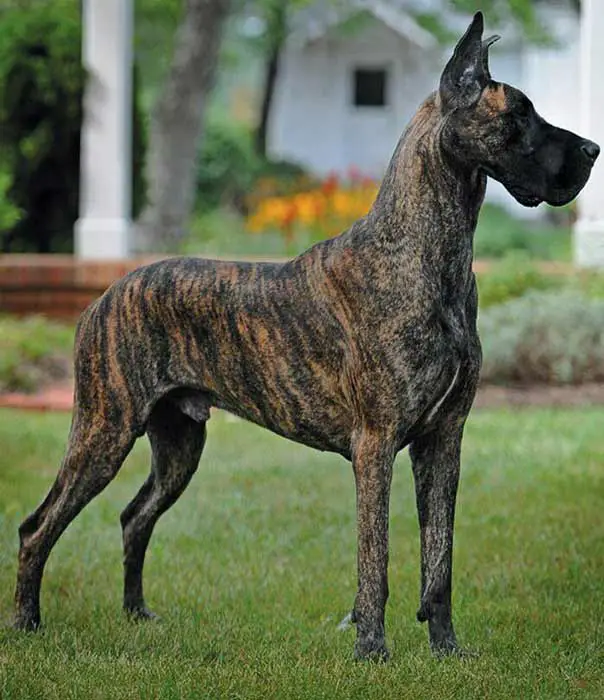
Black and Blue
- Black – a glossy black color with markings on the chest and feet especially toes.
- Blue – pure steel blue with white markings on the feet and chest.
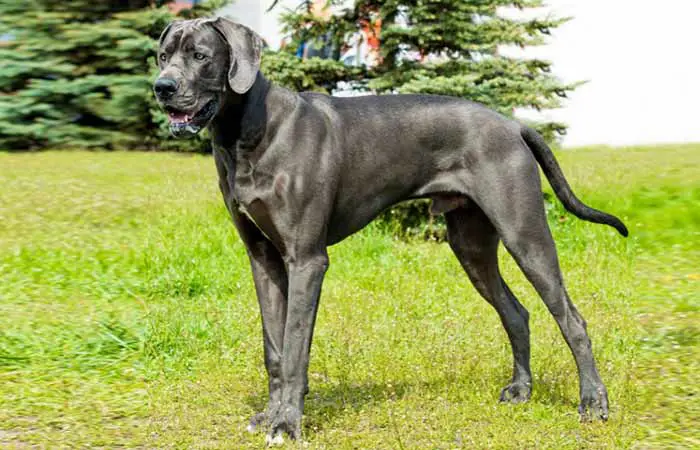
Harlequin and Mantle
Harlequin – a pure white base color with black patches regular and unique for each dog. A pure white coat is primarily seen in the neck with patches distributed everywhere else. The patches are medium-sized to appear more than a stippled or dappled effect.
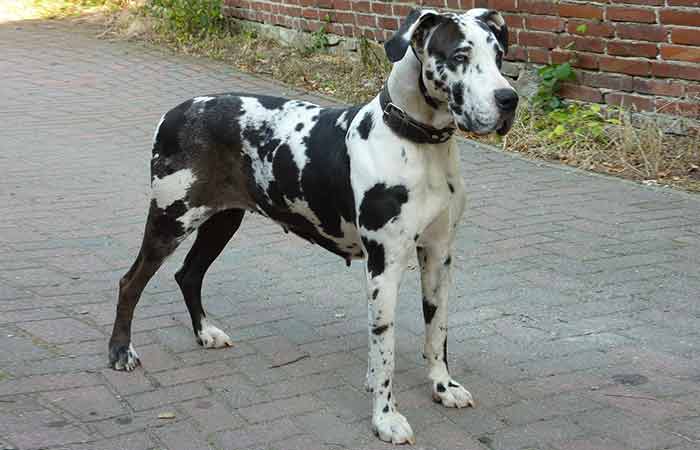
Mantle – also known as Boston effect, the color is an acceptable combination of black and white with a solid black blanket, blackhead but white muzzle, white chest, white blaze, and option white fore and hind legs. A white-collar is also acceptable.
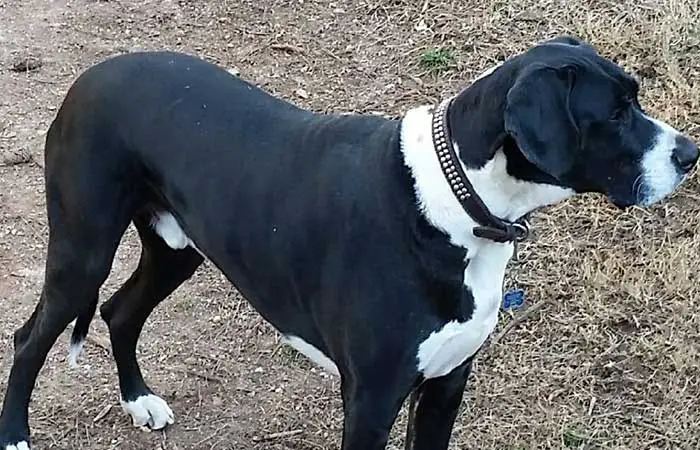
Brown/ Chocolate Great Danes
Great Danes bearing chocolate or brown hue are not included in standard coat colors of the breed. The brown coat color in Great Danes is an expression of a recessive gene existing in all carrier dogs of the breed. They are not rare but rather responsible breeders refrain from breeding.
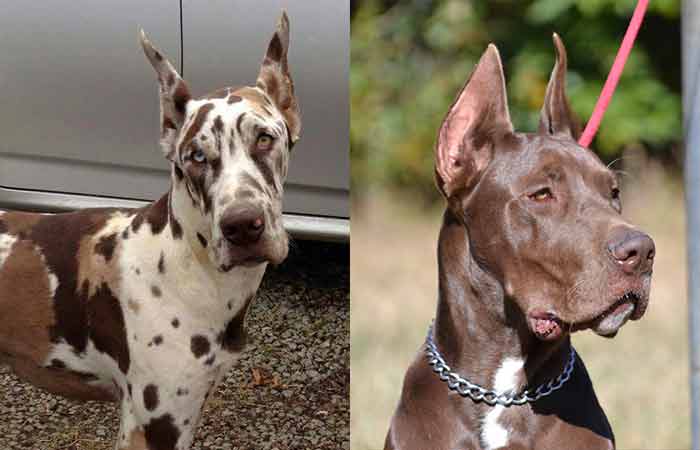
Unpopular Colors
There are other colors yet to be accepted or recognized including;
- Grey merle – just recently, the Grautiger dogs have been accepted under the FCI. They’re just another black and white combination but slightly different than the Harlequin. Patches and blotches are what determine acceptable and unacceptable choices.
- Fawnequin
- Brindlequin
- Merlequin
- White Great Dane
- Merle and blue merle
Blue Great Dane
To start, the blue great dane is a rare but standardbred color acceptable in dog shows. They’re a tainted variant of the black great dane that has a recessive gene that dilutes the black dominant gene of the dog.
They may have markings or spots on their chest and toes unlike pure black great danes and certainly have a more glossy steel blue appearance.
Blue Great Danes with fawn, brindle, or white markings are not standard colors which makes them unacceptable to participate in dog shows. Pure breeds are meant to have a homogenous steel blue coat, blue eyes, and naturally floppy ears. Other eyes colors could be brown- dark or light, or amber.
Their weight ranges between 90 to 130 pounds, heavier for males. Their height stands at 28 – 34 inches. They have an average lifespan of six to nine years.
Their temperament doesn’t differ much from what we all know. They’re gentle, kind, loyal, friendly, and great at obedience training. They’re smart, intelligent, and gets along pretty well with their owners.
The dogs are guard dogs, hence very possessive and territorial and can be ferocious and intimidating to strangers. The Blue Great Dane however, suffers from separation anxiety when left alone for long by their owners.
Blue Danes are very active canines that need regular exercise like a 20 – 40-minute walk daily.
The blue great dane can be crossbred by a Harlequin to make the Blue Harlequin Great Dane that’s subtle, has blue eyes, blue coat with harlequin markings on its body.
Even with such a great combination, the mix isn’t recognized as a standard; the Blue Harlequin Great Dane falls under the category of imperfect and flawed Blue Great Dane line.
Mantle Great Dane
Next up is the blanket dog depicted by the black coat extending over its body like a blanket. They are small white markings on their coat like on the collar, collar, chest, legs, and tail.
The Mantle Great Dane is an acceptable standard maybe because they have an alluded resemblance to the Boston Terriers.
As an accepted breed, they are allowed to attend shows and participate in championships as long as they possess the color, patterns, and markings as stated by the A.K.C. and G.D.C.A. standards;
“Any variation in color or marking shall be censured and regarded as a deviation”
The Great Danes that have deviations are said to be mismarked which doesn’t necessarily make them a rarity. Mismarks for example include non-white color spots like fawn, brown, merle, or blue.
- Blue Mantle Great Dane – a mismark of the mantle Great Dane, hence unrecognized in the USA. However, it’s acceptable in Europe as long as the black is substituted by blue and the eye color is grey, light amber, or yellow.
- Mantle Merle Great Dane – they have a warm personality, very amicable and loyal. The only downside is that you can compete in dog shows with them.
There are many more possibilities of mixed and mismarked mantle great danes because breeders come up with different breeds every time. You just have to know what you’re buying.
The mantle great dane has a brilliant black and white contrast in colors, especially on the face. This is what majorly differentiates them from the black and white harlequin coat. The mantle has a calm sanguine appearance which is also seen with their markings on the face.
Besides the clear color contrast, they are a black skull, white muzzle, partially or wholly white neck, a white chest, white fore, and hind legs, and a white-tipped but black tail. As is the norm with Great Danes in the USA, the Mantle great danes also have ear cropping, especially if there are championships. The practice of ear cropping is widely performed on cosmetic grounds, nonetheless, it’s a prohibited practice in European countries.
The Mantle great dane is compatible with an apartment life as they’re very friendly and have a low or medium level of energy. They don’t need vigorous activities to keep them fit and healthy besides the casual walks. Other than that, they enjoy laying on the couch and relaxing.
Harlequin Great Danes
A prevalent special dog is the Harlequin Great Dane that has black patches on its white base coat. They’re very easy to distinguish from the other types of dane colors because of the color and pattern. Generically, the Harlequin has one or two Merle gene mutations which gives them different and unique patches on their coat. According to the A.K.C. and G.D.C.A. standards,
“The base color for a Harlequin Great Dane must be pure white with torn black patches over the body. In addition, Merle patches are also acceptable.”
Harlequin Great Danes are the most demanding coat color of the breed. It’s said to not be an actual type of Great Dane but a merle since there are two such mutations on their gene. Hence, the proper name should be Harlequin merle great dane.
Nonetheless, the harlequin patterns and markings remain the same as black torn patches of a white full or partial coat over the body. The black pigment is only supposed to be patches and not a blanket as that will be ruled out as a mismark.
The harlequin’s black patches ought to be evenly dispersed all over its body, small and not very big. Plus, the patches could appear grey which remains a breed standard according to AKC
Harlequin great danes’ have quirky and heavenly eyes in varied colors like dark, brown, or blue. They have a pink nose as a puppy as it turns black when they mature. This particular type of great dane is said to have the most warmth and benignity.
They enjoy obedience training and are very friendly even with strangers. Luckily, they can also be the apartment living kind as they don’t require high-level activities, not are they highly active.
The harlequin great danes were already ruled out as the most friendly canines, loving with kids and other canines, plus very loyal and protective with their owners. For a 120 pounds dog and a height of 34 inches, that wasn’t the type of character you would expect.
Piebald Great Danes
The last type of Great Dane is the Piebald Dane that’s often seen as a mismarking of the breed in general. Piebalds have a mantle head, white body, and several black splotches, they have many possibilities. This is why they haven’t yet been recognized by either A.K.C. or by G.D.C.A. as the Great Dane breed standard.
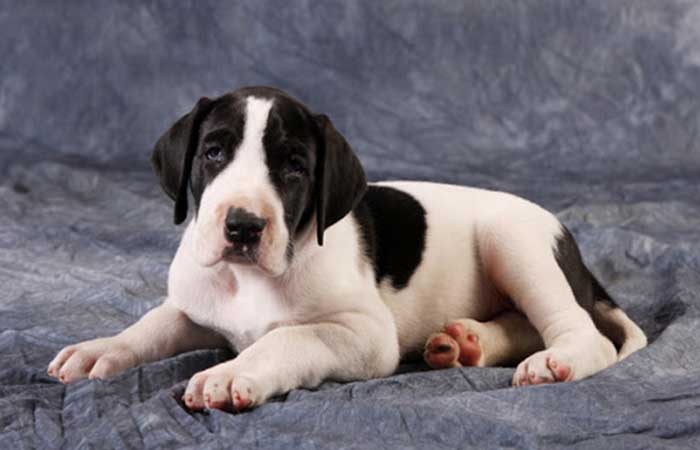
The piebald dane is not rare as it’s a result of breeding two mantles, however, genetic makeup hasn’t yet been understood and therefore not able to be standardized. Because they also have a similar appearance to the harlequins, there is the possibility that they are a mismark from both.
By definition, the Piebalds are named pinto, particolored, and colored-headed whites. As a phenotype, the piebald is a common coat pattern seen in many breeds but the disparity comes where they have fewer spots than the Harlequin.
A Piebald great dane has a full black head, one side black while the other is white with a few black patches, they also have three big splotches on their body, probably on one side, and a colored tail. They have dark eyes and a white muzzle. Leg markings can also be seen in some types of dogs.
The Piebald can have variations because of different combinations, these include;
- Fawn Piebalds
- Harlequin Piebald – also known as a harlequin head white. The Danes are born when the piebald gene fused with a harlequin gene. A Harlequin Piebald has a few body spots but it’s regarded as a normal Harlequin genetically.
- Merle Piebald – these have Merle heads where the piebald gene was integrated with the Merle gene to form the merle piebald.
Merlequin Great Danes
Merlequin Great Danes in simple terms are two merles alluded as merlekins. For the mixture to work. A Merle great dane can give birth to a harlequin if they have the recessive gene for the breed.
Fawnequin
Fawnequin Great Dane dogs are yet another mismark for the Great Dane breed. They aren’t recognized hence can’t participate in shows but they can be family pets.
A fawnequin wears a white base coat but has fawn splotches. This is often the case where both parents have a fawn gene and either parent has the recessive or dominant gene of the harlequin.
This is also the case for the Brindlequin where the Harlequin gene is acquired from the parent as a dominant or recessive gene while they also carry brindle genes. The brindle coat will follow the fawn coat pattern, and the fawn follows the black patterns on a pure harlequin.
The piebald, Merlequin, Fawnequin, and Brindlequin are not standard Great Dane types but they are there and their color patterns and mismarks are not an indication of any health issue but just different genetic results from crossbreeding.
Sources






